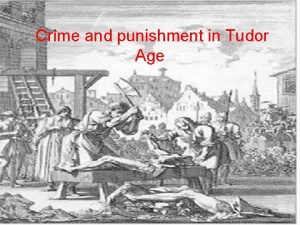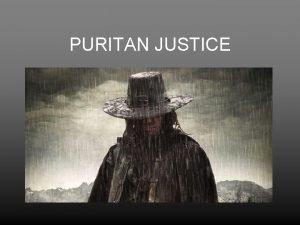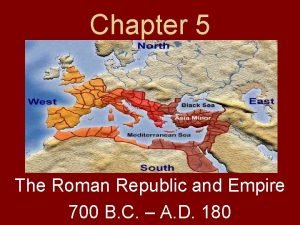ROMAN CRIME AND PUNISHMENT ROMAN CRIME AND PUNISHMENT






















































- Slides: 54

ROMAN CRIME AND PUNISHMENT

ROMAN CRIME AND PUNISHMENT A. PRELUDE: OF VESTAL VIRGINS AND PROSTITUTES B. ROMAN LAW: AN OVERVIEW C. ROMAN FAMILY AND THE LAW D. FROM REPUBLIC TO EMPIRE: A HISTORICAL SNAPSHOT E. ADMINISTRATION OF ROMAN JUSTICE

A chief Vestal Virgin A scene of prostitution from Pompeii

Six Vestal Virgins served simultaneously

Vestals seated at a banquet with a male figure (probably the Pontifex Maximus)

The remains of the House of the Vestals in Rome

A consul is accompanied by two lictors in the 1 st century BCE

Fasces were symbols of Roman law and the power of the state. These particular ones are beside the Speaker’s rostrum in the U. S. House of Representatives.

The remains of the Temple of the Vestals in the foreground

The Campus Sceleratus: The burial ground for disgraced Vestals

The execution of Oppia in 483 BCE as depicted in a later print

A Roman floor mosaic depicts a scene involving a prostitute

A later stylized imagining of the Floralia Festival

PROSTITUTION IN ANCIENT ROME Ancient Rome knew no comprehensive “law of prostitution. ” Under the Republic, prostitutes and pimps were burdened with a bundle of restrictions that excluded them from the responsibilities and privileges of full Roman citizenship. Female prostitutes were banished from certain cults celebrated by respectable women. Male prostitutes and pimps were excluded from all participation in political office and from service in the army. The law did, however, grant prostitutes official sanction. The state kept a register of prostitutes and imposed a tax on prostitution. Prostitutes were seen as an outlet to distract potential predators from sexually violating women of honour and social standing.

Romulus and Remus battle to the death

Jacques-Louis David’s famous representation of the Sabine Women (1799)

The opening pages of the Code Napoleon (1804)

SOCIAL CONTROL AND MAINTAINING ORDER Rome lacked a police force until the era of Augustus and did not allow military forces into the city itself. Rome does seem to have been a much more violent place than would be tolerated in a modern city. “Self-help” was officially sanctioned. Socially “deviant” behaviour that was not completely outlawed was still stigmatized through the notion of infamia (disgrace). This was a formal status imposed on persons involved in various suspect activities and had a consequence of placing limits on participation in public and legal life.

LEGAL INEQUALITY Equality before the law was not a Roman concept. Clear distinctions were made between Romans and non-Romans; between men and women; between freedmen and slaves – and even among citizens. One important distinction was between ius civile (“citizen law”), the body of common laws that applied to Roman citizens, the ius gentium (“law of peoples”), the body of common laws that applied to foreigners and their dealings with Roman citizens. By the 2 nd century CE, Roman citizens were divided into two classes for criminal jurisdiction: the honestiores (“more honorable”) and the humiliores (more insignificant). Slaves were at the lowest end of the status hierarchy.

A Roman slave collar

PATERFAMILIAS One of the key status inequalities in Roman law was between the father and the other members of the family. The paterfamilias exercised a virtually unrestrained authority over all members of the household, who were said to be in his power. The authority of the father over his children was called patria potestas, “fatherly power. ” The paterfamilias might maintain a domestic prison cell, the ergastulum. In case of divorce, the father had the power to assign children as he saw fit.

PARRICIDIUM The killing of a parent was classified as a specific crime in Roman law. Traditionally, the culprit was subject to the penalty of the sack. The perpetrator was sewn into a leather sack in company with a dog, a monkey, a snake and a rooster, and then thrown into the Tiber.

The reign of Augustus (31 BCE -14 CE) marked the transition from the Republic to the Imperial Era

Augustus’ daughter Julia represented in exile by the modern painter Pavel Svedomskiy

PROVISIONS OF THE LEX JULIA (18 BCE) Adultery focused on the woman; it comprised sexual relations between an “honorable” married woman and a man not her husband. The law made the offense a crime punishable by exile and confiscation of property. A father could legally kill his daughter and her lover if they were surprised in the act; the husband could kill his wife’s lover if he was of marginal status. After conviction, neither party could ever give testimony before a court. A woman convicted under the adultery statute as forbidden to remarry and was compelled to wear the toga as a symbol of their shame (she was thus symbolically associated with prostitutes). Under the lex Iulia, a husband was required to divorce a wife caught in the act of adultery and to bring an accusation against her. Husbands who condoned adultery by their wives could be accused of lenocinium, acting as a pimp or procurer.


The violent meeting of Mars and Rhea Silvia as represented by Reubens

Tarquin’s rape of Lucretia as represented by Titian (1571)

Lucretia’s corpse is displayed in the Forum (Botticelli)

Brutus depicted with Lucretia and her suicide knife

The Twelve Tables (451 -50 BCE) displayed in the Forum

THE TWELVE TABLES They dealt chiefly with private disputes between individuals. The main topics covered are the family, marriage and divorce, property, debt and legal procedure Personal assault, up to and including murder, was still a private matter, and law existed merely to ensure that reparation was made to the injured party, either through monetary recompense or, if agreement could not be reached, a talio – retaliation in kind. The Twelve Table mandated the death penalty for a number of crimes, including theft by night in the city, treason, or for performing an exorcism to make another’s crops sterile. Debtors could be punished by being sold into slavery.


AFTER THE TWELVE TABLES From the mid-second century BCE, the Roman state began to establish specific courts, the quaestiones perpetua to try particular offenses. This began with the Lex Calpurnia on extortion in 149 BCE.

The Dictator Cornelius Sulla is credited with making the first serious attempt to organize the different quaestiones.

LAW AND ORDER DURING THE EMPIRE Under the Empire, increasingly the emperor came to rule by issuing orders. The state took on a more active role, and offenses that were previously considered private began to be conceived as public penal matters. The jury trial was used less frequently and the quaestiones perpetuae were gradually replaced by the cognitio procedures. Although the emperor himself became the chief source of law, he relied on the advice of legal specialists, the “jurists, ” who helped to interpret and codify the law.

ROLE OF THE JURISTS As distinct from advocates, the Roman profession of jurists consisted of individuals who wrote commentaries upon the law rather than arguing in the courts themselves. Beginning in the late Republican period and extending into the Imperial era, a tradition of legal expertise here developed that was unequalled anywhere in the ancient world. A legal literature emerged that was characterized by technical language and insider expertise. Perhaps the writings of Lucius Salvius Julianus (Julian), one of the most famous of the jurists, can be held up as an exceptional example. His second century CE Digesta was a 90 -book systematic exposition of the law and its major statutes.

A 1581 edition of The Digest (originally produced 533 CE)

Justinian I codified the Corpus iuris civilis (“Body of Civil Law”)

THE ADMINISTRATION OF ROMAN JUSTICE The English word “crime” is derived from the ancient Latin crimen (“reproach”) – there was no one word for “crime” in Roman law. The Romans did distinguish between ius publicum (“public law”) and ius privatum (“private law”). These only very approximately correspond to today’s categories of “civil” and “criminal” law.

JUDICIAL PROCESS FOR PUBLIC TRIALS Ancient Rome had no public prosecution service – individual citizens had to bring cases themselves. The first step was postulation, a request to the magistrate for permission to bring the charge. The accuser was obliged to register his charge by formal inscription. A period of inquisition in which the case was prepared followed. Juries comprised approximately 25 -27 members. There was no jury deliberation and no chance for appeal.

THE PROFESSIONALS An advocate had training and experience primarily in public speaking and aided particularly with the defense. Jurists’ role was primarily in interpreting and explaining the law. Most usefully to us, jurists came to publish their legal opinions.

A later representation of execution from the Tarpeian Rock

TYPES OF PUNISHMENT Execution (decapitation with a sword; being thrown from the Tarpeian Rock, crucifixion, burning alive, exposure to wild animals) Exile (exsilium was the name given to opting for voluntary exile before the sentence was pronounced; relegatio was temporary banishment to a place or exclusion from living in certain places; deportatio was perpetual banishment to a place with loss of citizenship and confiscation of property). Corporal Punishment Imprisonment Fines

A depiction of Nero’s persecution of the Christians


The Roman Colosseum became a venue for state execution

A representation of damnatio ad bestias

SEVERE MILITARY PUNISHMENTS Decimatio (decimation): Applied to a unit, this involved the killing of every tenth man selected by lot. Fustuarim: A punishment associated with a number of offenses, including falling asleep on watch, it involved being beaten to death by comrades wielding cudgels. Lesser punishments included fines, fatigue duty or dishonorable discharge.

REPUBLICAN OFFENSES Ambitus: Electoral briberty Homicide Vis: Violence against the state Falsum: Counterfeiting of coins and forgery of will Peculatus: Theft of state-owned property Maiestas: “Diminishing the majesty of the Roman people. ”

PRIVATE PROCEDURES The procedures for private trials fell into two quite distinct phases 1) iure (“at law”) was a kind of preliminary hearing in which the parties consulted with an elected magistrate on the ground rules for the hearing. 2) The trial proper was called the apud iudicem (“before a judge”).

TYPES OF DELICTS Damnum Iniuria Datum – Property Damage Futum (Theft) Iniuria

The Praetorian Guard declare Claudius the new emperor

Vigils serve as firefighters and also engaged in some street patrol
 Unit 4 crime and punishment
Unit 4 crime and punishment Crime and punishment revision guide
Crime and punishment revision guide Characters in crime and punishment
Characters in crime and punishment Tudor whipping
Tudor whipping Criminology unit 4
Criminology unit 4 Medieval crime and punishment facts
Medieval crime and punishment facts Gcse history past papers edexcel
Gcse history past papers edexcel Kahoot crime and punishment
Kahoot crime and punishment Crime and punishment in medieval japan
Crime and punishment in medieval japan Crime and punishment 1750 to 1900
Crime and punishment 1750 to 1900 Wjec criminology unit 4 past papers
Wjec criminology unit 4 past papers Crime and punishment key words
Crime and punishment key words Crime and punishment topic
Crime and punishment topic Unit 4 criminology
Unit 4 criminology Tsw crime and punishment
Tsw crime and punishment Puritan punishments
Puritan punishments Capital punishment thesis statement
Capital punishment thesis statement Plagiarism crime punishment
Plagiarism crime punishment Roman republic vs roman empire
Roman republic vs roman empire Roman republic vs roman empire
Roman republic vs roman empire Good boy morality
Good boy morality Wheel of misfortune mtg rules
Wheel of misfortune mtg rules Chapter 5 to kill a mockingbird
Chapter 5 to kill a mockingbird Fourth ring of hell
Fourth ring of hell Capital punishment definition
Capital punishment definition Labelling theory
Labelling theory How did romeo killing tybalt put juliet in a bad position
How did romeo killing tybalt put juliet in a bad position Positive punishment adalah
Positive punishment adalah Learned helplessness example
Learned helplessness example The target person complies because he or she believes
The target person complies because he or she believes Guidance vs punishment
Guidance vs punishment Fedral
Fedral Theorize how the tessera is another type of punishment
Theorize how the tessera is another type of punishment Capital punishment definition
Capital punishment definition Canto 7 divina commedia
Canto 7 divina commedia Panopticon school
Panopticon school Jeremy bentham punishment
Jeremy bentham punishment Steven spitzer theory
Steven spitzer theory Opportunists punishment inferno
Opportunists punishment inferno Hagans punishment pyramid
Hagans punishment pyramid From where does katniss recognize the girl with red hair
From where does katniss recognize the girl with red hair Punishment sex
Punishment sex Presentation punishment
Presentation punishment Good nnn punishments
Good nnn punishments Positive punishment def
Positive punishment def Sexual battery definition
Sexual battery definition Discipline without stress punishments or rewards
Discipline without stress punishments or rewards Nnn punishment
Nnn punishment Nnn punishment
Nnn punishment What warning does tiresias give to creon before he leaves?
What warning does tiresias give to creon before he leaves? Good nnn punishments
Good nnn punishments Domestic discipline lifestyle
Domestic discipline lifestyle Capital punishment mc
Capital punishment mc Collierville schools substitute teacher
Collierville schools substitute teacher Itnesity
Itnesity











































































